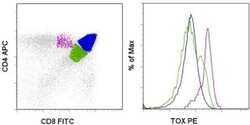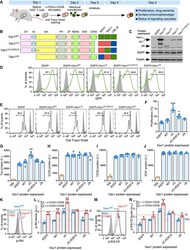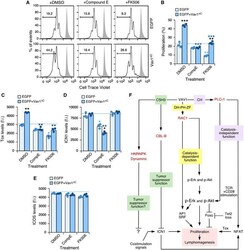Antibody data
- Antibody Data
- Antigen structure
- References [8]
- Comments [0]
- Validations
- Flow cytometry [1]
- Other assay [2]
Submit
Validation data
Reference
Comment
Report error
- Product number
- 12-6502-82 - Provider product page

- Provider
- Invitrogen Antibodies
- Product name
- TOX Monoclonal Antibody (TXRX10), PE, eBioscience™
- Antibody type
- Monoclonal
- Antigen
- Other
- Description
- Description: This TXRX10 monoclonal antibody reacts with human and mouse TOX, which is also known as Thymocyte selection-associated HMG box protein. This DNA-binding nuclear factor is expressed in thymocytes, T lymphocytes, NK cells, and lymphoid tissue-inducer (LTi) cells. TOX expression in thymocytes is upregulated during beta-selection and positive selection. Studies using Tox knockout mice have demonstrated a critical role for TOX in CD4+ T cell development as a regulator of the CD4loCD8lo to CD4+CD8lo transition. Moreover, TOX has been shown to be involved in the development of NK and LTi cells. While its regulation remains unclear, TOX expression has been shown to be induced by calcineurin-mediated TCR signaling in thymocytes during positive selection. Applications Reported: This TXRX10 antibody has been reported for use in intracellular staining followed by flow cytometric analysis. Applications Tested: This TXRX10 antibody has been tested intracellular flow cytometric analysis of mouse thymocytes using the Foxp3 Buffers (Product # 00-5521-00) and protocol. This can be used at less than or equal to 0.5 µg per test. A test is defined as the amount (µg) of antibody that will stain a cell sample in a final volume of 100 µL. Cell number should be determined empirically but can range from 10^5 to 10^8 cells/test. It is recommended that the antibody be carefully titrated for optimal performance in the assay of interest. Excitation: 488-561 nm; Emission: 578 nm; Laser: Blue Laser, Green Laser, Yellow-Green Laser. Filtration: 0.2 µm post-manufacturing filtered.
- Reactivity
- Human, Mouse
- Host
- Rat
- Conjugate
- Yellow dye
- Isotype
- IgG
- Antibody clone number
- TXRX10
- Vial size
- 100 μg
- Concentration
- 0.2 mg/mL
- Storage
- 4°C, store in dark, DO NOT FREEZE!
Submitted references Extracellular acidosis restricts one-carbon metabolism and preserves T cell stemness.
Characterization of the spectrum of trivalent VAV1-mutation-driven tumours using a gene-edited mouse model.
Functional assessment of the cell-autonomous role of NADase CD38 in regulating CD8(+) T cell exhaustion.
Distinct phenotypic states and spatial distribution of CD8(+) T cell clonotypes in human brain metastases.
Cancer-associated mutations in VAV1 trigger variegated signaling outputs and T-cell lymphomagenesis.
Uptake of oxidized lipids by the scavenger receptor CD36 promotes lipid peroxidation and dysfunction in CD8(+) T cells in tumors.
Single-cell transcriptome analysis reveals TOX as a promoting factor for T cell exhaustion and a predictor for anti-PD-1 responses in human cancer.
Landscape of Exhausted Virus-Specific CD8 T Cells in Chronic LCMV Infection.
Cheng H, Qiu Y, Xu Y, Chen L, Ma K, Tao M, Frankiw L, Yin H, Xie E, Pan X, Du J, Wang Z, Zhu W, Chen L, Zhang L, Li G
Nature metabolism 2023 Feb;5(2):314-330
Nature metabolism 2023 Feb;5(2):314-330
Characterization of the spectrum of trivalent VAV1-mutation-driven tumours using a gene-edited mouse model.
Robles-Valero J, Fernández-Nevado L, Cuadrado M, Lorenzo-Martín LF, Fernández-Pisonero I, Abad A, Redín E, Montuenga L, Martín-Zanca D, Bigas A, Mallo M, Dosil M, Bustelo XR
Molecular oncology 2022 Oct;16(19):3533-3553
Molecular oncology 2022 Oct;16(19):3533-3553
Functional assessment of the cell-autonomous role of NADase CD38 in regulating CD8(+) T cell exhaustion.
Ma K, Sun L, Shen M, Zhang X, Xiao Z, Wang J, Liu X, Jiang K, Xiao-Feng Qin F, Guo F, Zhang B, Zhang L
iScience 2022 May 20;25(5):104347
iScience 2022 May 20;25(5):104347
Distinct phenotypic states and spatial distribution of CD8(+) T cell clonotypes in human brain metastases.
Sudmeier LJ, Hoang KB, Nduom EK, Wieland A, Neill SG, Schniederjan MJ, Ramalingam SS, Olson JJ, Ahmed R, Hudson WH
Cell reports. Medicine 2022 May 17;3(5):100620
Cell reports. Medicine 2022 May 17;3(5):100620
Cancer-associated mutations in VAV1 trigger variegated signaling outputs and T-cell lymphomagenesis.
Robles-Valero J, Fernández-Nevado L, Lorenzo-Martín LF, Cuadrado M, Fernández-Pisonero I, Rodríguez-Fdez S, Astorga-Simón EN, Abad A, Caloto R, Bustelo XR
The EMBO journal 2021 Nov 15;40(22):e108125
The EMBO journal 2021 Nov 15;40(22):e108125
Uptake of oxidized lipids by the scavenger receptor CD36 promotes lipid peroxidation and dysfunction in CD8(+) T cells in tumors.
Xu S, Chaudhary O, Rodríguez-Morales P, Sun X, Chen D, Zappasodi R, Xu Z, Pinto AFM, Williams A, Schulze I, Farsakoglu Y, Varanasi SK, Low JS, Tang W, Wang H, McDonald B, Tripple V, Downes M, Evans RM, Abumrad NA, Merghoub T, Wolchok JD, Shokhirev MN, Ho PC, Witztum JL, Emu B, Cui G, Kaech SM
Immunity 2021 Jul 13;54(7):1561-1577.e7
Immunity 2021 Jul 13;54(7):1561-1577.e7
Single-cell transcriptome analysis reveals TOX as a promoting factor for T cell exhaustion and a predictor for anti-PD-1 responses in human cancer.
Kim K, Park S, Park SY, Kim G, Park SM, Cho JW, Kim DH, Park YM, Koh YW, Kim HR, Ha SJ, Lee I
Genome medicine 2020 Feb 28;12(1):22
Genome medicine 2020 Feb 28;12(1):22
Landscape of Exhausted Virus-Specific CD8 T Cells in Chronic LCMV Infection.
Sandu I, Cerletti D, Oetiker N, Borsa M, Wagen F, Spadafora I, Welten SPM, Stolz U, Oxenius A, Claassen M
Cell reports 2020 Aug 25;32(8):108078
Cell reports 2020 Aug 25;32(8):108078
No comments: Submit comment
Supportive validation
- Submitted by
- Invitrogen Antibodies (provider)
- Main image

- Experimental details
- C57Bl/6 thymocytes were stained with Anti-Mouse CD4 APC (Product # 17-0041-82) and Anti-Mouse CD8a FITC (Product # 11-0081-82), followed by intracellular staining with 0.5 µg of Anti-Human/Mouse TOX PE using the Foxp3 Staining Buffer Set and protocol (Product # 00-5521-00). The histogram (right) demonstrates TOX staining of CD4+CD8+ (blue histogram), CD4loCD8lo (green histogram), and CD4+CD8lo (purple) thymocytes. Cell populations were gated as indicated on the dot plot (left). Cells in the lymphocyte gate were used for analysis.
Supportive validation
- Submitted by
- Invitrogen Antibodies (provider)
- Main image

- Experimental details
- Figure 6 Vav1 DeltaC -mediated proliferation requires engagement of several downstream pathways A Schematic representation of the experiments used in this figure. See details in main text and Materials and Methods. B Depiction of the Vav1 mutants used in these experiments. The E201A mutation is shown as a gray circle. The activity of each mutant is represented on the right. Green box, WT activity; red box, gain of function; blue box, loss of function. C Representative immunoblot showing the abundance of the ectopic Vav1 proteins, EGFP, and the endogenous tubulin alpha (loading control) in CD4 + T cells transduced with retrovirus particles used in these experiments (top). D Representative FACS plots showing EGFP epifluorescence in CD4 + T cells transduced with retroviruses encoding the indicated proteins (top). Numbers indicate the relative percentage (%) of the EGFP + cell population in each case. Gray shaded histograms represent the fluorescence obtained from CD4 + T cells nontransduced with retrovirus particles. Similar results were obtained in CD4 + T cells transduced with virus encoding EGFP ( n = 6), Vav1 WT ( n = 6), Vav1 DeltaC ( n = 6), Vav1 DeltaC+E201A ( n = 6), and Vav1 DeltaN ( n = 3). E, F Representative FACS plots (E) and quantification (F) of the proliferation of EGFP + CD4 + T cells expressing the indicated proteins using the Cell Trace Violet method. In (E), the gray shaded histograms represent the fluorescence obtained from nonstimulated CD4 + T cells before
- Conjugate
- Yellow dye
- Submitted by
- Invitrogen Antibodies (provider)
- Main image

- Experimental details
- Figure 7 Vav1 DeltaC -driven CD4 + T-cell proliferation requires ICN1 and proper calcineurin signaling A, B Representative FACS plots (A) and quantification (B) of the EGFP + CD4 + T-cell proliferation in the different experimental groups (right) and indicated experimental conditions (top) using the Cell Trace Violet detection method. In A, gray shaded histograms represent the fluorescence obtained from nonstimulated CD4 + T cells before stimulation and retroviral transduction. n = 3 independent experiments. C-E Flow cytometry determination of intracellular Tox (C), intracellular ICN1 (D), and surface ICOS (E) levels in EGFP + CD4 + T cells expressing the indicated Vav1 proteins. f.i., mean fluorescence intensity relative to the isotype-matched control antibody. n = 3 independent experiments. F Summary of the Vav1-regulated signaling pathways that contribute to promote the proliferation of primary CD4 + T cells that have been unveiled in this work. The other downstream effectors and pathways of Vav1 are indicated. The main primary effectors as shown in red. Data information: In panels (B, C, D, and E), values are shown as means +- SEM from three independent experiments. P -values are given relative to nontreated (light blue asterisks) and treated (dark blue asterisks) EGFP + cells. We also include P -values for the values exhibited by each experimental group relative to those obtained in nontreated condition (black asterisks). * P
- Conjugate
- Yellow dye
 Explore
Explore Validate
Validate Learn
Learn Flow cytometry
Flow cytometry